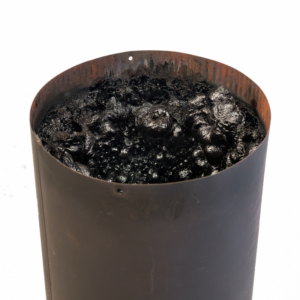If you own a fireplace, then you’ve probably heard time and time again how important annual inspections are. These give your sweep the chance to spot imperfections and buildup, and they ensure you avoid dangerous scenarios like smoke back-up, gas leaks, and chimney fires.
What is a chimney fire? A chimney fire is when flames spread up and through your chimney, rather than staying in the firebox where they belong.
Many assume their tough masonry chimney could easily withstand these high temperatures, but your brickwork and mortar aren’t actually built for direct contact with flames. Because of this, chimney fires will cause your mortar joints
to melt and your bricks to crack and crumble.
As you might guess, using your fireplace after a chimney fire has occurred can invite some serious risks. You’ll likely have gaps in your masonry through which smoke, flames, and dangerous gases can now enter your home.
And since most chimney fires are quiet and slow-moving, you could experience one without even realizing it! In situations like these, homeowners will simply continue building fires, not realizing they’re putting their home and family at risk by doing so. (This is another big reason why annual inspections are so important!)
So, what causes chimney fires and how can they be avoided down the line? Well, to dig into that, we’ll have to talk about creosote.
All About Creosote
 Creosote is a flammable substance that forms along the interior walls of your chimney as you burn fires. As the fumes and vapors from your fireplace reach the top of the chimney and cool down, condensation forms and clings to your masonry. The sticky residue that appears as a result of this is creosote.
Creosote is a flammable substance that forms along the interior walls of your chimney as you burn fires. As the fumes and vapors from your fireplace reach the top of the chimney and cool down, condensation forms and clings to your masonry. The sticky residue that appears as a result of this is creosote.
Creosote is dark brown or black in color, and it can be light and flaky, tar-like and sticky, or glazed, hard, and glossy. It’s also very flammable, which is why you don’t want a lot of it building up in your flue. This is why those regular chimney sweepings are such an important investment! Excess creosote is the leading cause of chimney fires.
Wondering how you can minimize creosote accumulation? Here are some tips:
- Warm your flue before lighting a fire. This can be done by taking a rolled up piece of newspaper, lighting in, then holding it in your flue. This also helps to ensure smoke doesn’t get pushed back into your living space once you get your fire going.
- Invest in a top-sealing damper. Top-sealing dampers are great for sealing your chimney up tight when your fireplace isn’t in use, and since they sit at the top of your flue, they help keep your flue warmer, too. No more cold downdrafts and – you guessed – less creosote buildup.
- Burn only seasoned wood. The only thing you should be throwing on your fires are logs that have been dried out for at least six months. Ideally, they’ll be lightweight, dark/split at the ends, and they’ll smell musty and not fresh. You can also test your logs by smacking two pieces together. If you hear a hollow “clunk” (as opposed to a dull “thud”), that’s a good sign! In the end the less water in the wood, the less creosote you’ll end up with.
- Make draft and airflow a priority. Proper airflow is imperative for burning hotter, more efficient fires, which is a must when it comes to keeping creosote levels down.
- Stack your firewood appropriately. If your logs are packed tightly, but with decently sized gaps for air to circulate, your fires will burn hotter, cleaner, and quicker. This is ideal for keeping creosote deposits to a minimum. Slower burns, on the other hand, will result in more buildup.
- Avoid burning artificial logs. These give off more harmful byproducts than regular wood, and you’ll notice more creosote as a result.
Signs of a Chimney Fire
If you’re concerned that you’ve experienced a chimney, be sure to call in a professional chimney sweep to look things over as soon as possible – and don’t put your system to use until they examine everything.
In the meantime, though, there are some signs you can look for that may indicate a chimney fire has occurred.
- You have puffy/honeycombed creosote in your chimney.
- Your metal chimney components (like your cap or flashing) are warped and discolored.
- Your roofing materials show signs of damage.
- You notice smoke coming through your masonry walls.
- Your flue tiles are damaged or missing large chunks.
- You notice creosote flakes around your chimney.
- There are cracks in your masonry chimney.
Need Care Soon? Give Us a Call!
The team at The Chimney Guys, LLC is CSIA-certified, experienced in the field, and we offer a long list of services, so whatever chimney issues you’re experiencing, we can help. We’re also licensed, insured, and family-owned – you can definitely rest easier when you trust in us!
If you’d like to book your next appointment, reach out today to set things up. We’d love to hear from you soon!

Recent Comments